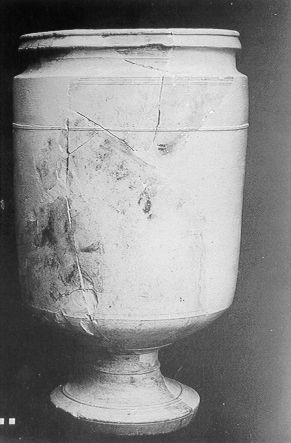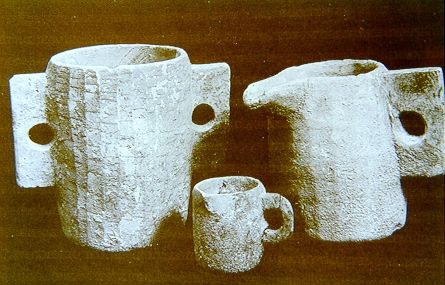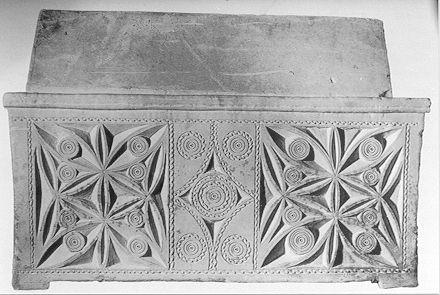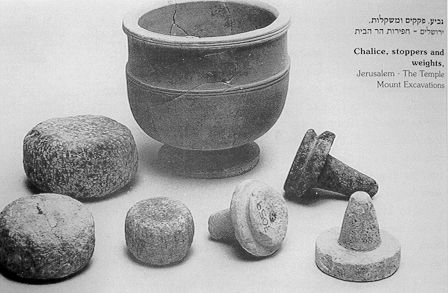
Issue O024 of 7 December 2002
Purity Broke Out In Israel
Stone Vessels in the Late Second Temple Period
By
Norman A. Rubin
Journalist, Indep. Scholar
Vessels made of stone have always occupied a prominent position among the artifacts used by man. Such vessels were used mainly for grinding and pounding, and were fashioned out of hard limestone or basalt. The material culture of the Second Temple Period (1) was marked by the appearance of a different type of stone vessel, made of both white and bituminous chalk (a soft limestone).
Stone vessels in use during the Second Temple period, connects the wide dispersal of these artifacts with the increased strictness of observance of the laws of purity and defilement in the Halakah, which is the entire body of Jewish law and tradition, comprising the laws of the Bible and the oral law as transcribed in the legal section of the Talmud (2). This characterized the way of life of the ancient community of Israel. The stone vessels, according to the requirements of the Halakhah (3), were divided into four areas or 'gates'.
THE GATE OF RITUAL: The Holy Temple of the Jews was the principal factor for purity obligations, which were required not only within the Temple itself but also in an individual's everyday life. The use of stone vessels, which did not become defiled, had great importance, especially in connection with the service of the Priests of the Temple. (4)
THE GATE OF THE LIVING: Whereas preservation of the Temple from impurity was entrusted to the Priests (5); the task of strengthening the foundations of purity and keeping impure factors out of the Temple was given over to laymen, the ordinary Israelites themselves. It follows, therefore, that strictness in observing Halakhah penetrated into the everyday life of the individual; one manifestation of this care being the widespread use of stone vessels in the home of the Jewish family. The stone vessels join a long list of other evidence regarding this impurity of matter. Another example is the elimination of figurative or animal motifs on mosaics, wall paintings, ossuaries, and vessels.
THE GATE OF THE DECEASED: The stone vessel industry in the late Second Temple period supplied the Halakhah observant Jewish society with, on the one hand, stone vessels that could not be defiled and on the other, stone ossuaries intended to serve as receptacles for the bones of the deceased, which of course carried the most severe impurity. The two types - stone vessels and ossuaries - had several things in common; the period of time they were in use, the methods of their processing, the technique of their decoration, and the motifs of their ornamentation.
THE GATE OF PRODUCTION: The stone vessel industry instituted methods of production that were customary with other materials, especially wood. Some of the vessels, moreover, are imitations in stone of ceramic, wood, metallic, and glass vessels. The stone vessels alone, however, do not absorb impurity, and thus they were preferred over the others.
"You shall inscribe on the stones all the words of the law.” (Deut 27:8)
STONE VESSELS IN JEWISH HALAKHAH (as interpreted in the Talmud)
As a consequence of the Halakhic precept of strict observance of the purity laws (6) both in and outside the temple, a stone vessel industry began to develop in the Second Temple period. According to the 'Tosefta', additional commentaries to the Talmud (Tractate Shabbat. 13b), "Purity broke out amoung Israel".
The Mishnah lists groups of vessels that were not susceptible to becoming ritually unclean: cattle-dung vessels, stone vessels, and of unfired clay. (Kelim (vessels) 10:1, Parah (cow) 5:5, Oholoth (spices) 5:5, Yadayim (hands) 1:2) This group of vessels was made of materials originating in the earth, and according to the 'Halakhah', stone and earth do not become ritually unclean. The Mishnah defines an earthen vessel as one, which had not been fired in an oven, and determines: "After what time does an earthenware vessel become susceptible to uncleanness? From the time that it is fired in the furnace, for that is the completion of the manufacture". (Kelim 4: 4). Stone vessels were thus included among unfired vessels - being natural material.
There is a clear preference in the Mishnah for stone objects, as being ritually clean, over objects made of other material. If an oven is made of stone and metal, it is not susceptible to uncleanness as is a pottery oven, and if the metal becomes unclean it may be made clean; a stone oven, however, is not susceptible to uncleanness at all (Kelim 5:11). The Mishnah also asserts that a stone bath-house bench is not susceptible to unclean-ness (Niddah 9:3, references to a woman in her menstruation period.)
Stone vessels also appear as a separate group connected with water. "they may render (unclean) water clean by (surface) contact in a stone vessel, but they may not immerse it". (Mishnah, Betzah, 'Hypothetical Questions' 2:3); and similarly in the Tosefta, additions to the Talmud: "A person may not immerse water on a Festival, nor he may he make surface contact of water in a stone vessel to purify it on the vessel for Shabbath".
These laws stress the great importance of stone vessels in the purification of water on a Festival or on the Sabbath. Water kept in a stone vessel could be made ritually clean on a Festival and on a Sabbath, while water kept in a pottery vessel could not be made clean, since the instant the water became unclean, it imparted this uncleanness to the vessel as well, thus preventing the purification of the water it contained. This leads us to the assumption that the large stone vessels (called KALLAL, large jug, in the sources) were used to store ritually clean water for the water for the washing of the hands and for the ritual purification of those serving in the Temple. "He presented Aaron and his sons and washed them in water.” (Leviticus 8:6-7)
JEWISH OSSUARIES
Archaeologists found in uncovered Jewish tombs of the First Temple period a similarity between the burial custom of the Hebrews with those practiced by the Canaanites. Where terrain conditions permitted, natural caves, eventually extended, were used or else caves were hewn out of the rock. The Canaanites laid out the deceased on mats on the grave floor with grave goods placed nearby. Whereas in Jewish tombs one encounters benches hewn along the wall where the corpse was placed, and grave goods were placed nearby. When necessary, in both societies, remnants of former burials were removed to a communal charnel; they were found in Jewish burial sites hewn under or beside the benches. (In the Hellenistic period, loculi and arcosolia replaced the burial benches and a special chamber was set aside for a communal charnel.)
Throughout the varied periods of Jewish history, the burial customs proved satisfactory and sufficient, as the concept of the netherworld remained constant, a place for all deceased, whatever their conduct in life had been.
From the Hasmonean times, however a concept of life after death appeared in the belief of the Hassidim, a sect characterized by its emphasis on mysticism, prayer, ritual strictness and religious zeal. It was the belief in the communal resurrection of the dead, as expressed in Ezekiel 37:1-12 or in Isaiah 26:19. A similar view is to be found in several passages of the book of II-Maccabees; these passages link the sufferings and deeds of the living and their release from sin to the future resurrection of their bodies. By the end of Second Temple period this belief had been accepted by the majority of the people (Josephus, Antiquities 18:17). (7)
From ca. 20-15 BC, special stone receptacles (the so-called ossilegium) began to be used for the collection of the bones of the deceased. The deposition in such a receptacle proved to the deceased relatives that the person had atoned for their sins as the decomposition of the flesh was considered painful, thus atoning and expiating. The deceased now rested from Judgment and would eventually rise from these remnants. (8)
Within the era of the Second Temple, the belief of physical resurrection of the person stipulated the retention of the whole skeleton. Thus, a new receptacle was required; one that will withstand the decomposition of the bones in the Jerusalem climate. Local limestone suited this condition perfectly. The soft stone was found in ancient quarries around Jerusalem; the evidence of these quarries was through the archaeological discovery of wasters with tool marks.
The containers thus fashioned, the ossuary, is called in contemporary Jewish literature 'GLOSKEMA' and is known as as 'HALATH' in Aramaic and 'SOROS' in Greek. The outline of these ossuaries was copied from wooden boxes found in households of this period with a flat base, at times with low feet, and gabled, vaulted, or flat lid in keeping with the purity laws.
An ossuary dimensions were determined by its contents; length by the body's longest bones', width by pelvis and skull; height by the total amount of bones. This was done in accordance with a rule that stated: "Whomsoever a person sleeps with when living, may be buried when dead." (Semahot 13:8)
Most ossuaries remain plain, free from decoration with simple chisel alphabetic cuts in either Hebrew or Greek, designating the name or the family status of the deceased. But priests of the Temple and the wealthy members of the Jerusalem society had elaborate designs carved on the ossuaries for their departed - rectangles, triangles, circles. At times, a motif may be added such as rosettes interlaced in a circle or with representations of a tree or a plant. In a few cases, an ossuary was crowned with an elaborated decorative gable and its sides with architectural elements - a door or a column between rosettes.
CONCLUSION
When, in 70 AD., the Temple and Jerusalem were destroyed during the 'War with Rome', and the Jewish population of Judea, Galilee, and the Golan suffered reverses in the aftermath of the defeat, many laws connected with ritual cleanness of the Temple lapsed, and the stone vessel industry declined and disappeared almost completely.
NOTES
(1) Stone vessels first appeared in the second half of the 1st century BC, while their main distribution occurred in the 1st century AD. The presence of these vessels (mainly in characteristically Jewish areas, such as Jerusalem, Judea and the Galilee) and their sudden disappearance after the destruction of the Second Temple during the revolt against Rome, suggest that the stone vessel industry during the Second Temple period was a distinct Jewish phenomenon connected with Jerusalem and the Temple, Jewish religious law, and the Jewish population.
(2) TALMUD' - the collection of Jewish law and tradition comprising the Mishnah and Gemera. The 'Mishnah' is a collection of oral laws compiled about AD 200 by Rabbi Judah ha-Nasi and forming the basis of the 'Talmud'. The 'Gemara' is the section of the 'Talmud' consisting essentially of commentary of the 'Mishnah'.
(3) Definition of cleanness and uncleanness are of Biblical origin, "Laws of Purification and Atonement" (Leviticus - chapters 11 to 17.) and during the Second Temple period they were expanded and discussed in the 'Order of Tohorot (ritual)' in the Mishnah.
(4)"Only those in a state of ritual purity might approach diety."(Leviticus) "'Holy' is that which has to do with God, and everything that belongs to god is 'holy'." Ritual cleanness has to do partly with the preservation of society and partly with the other world of natural religion which is a sanitary necessity.
(5) "Ritual of Purity and Impurity" (Tumah ve-toharah - Hebrew) This ritual is a concept that a person or object can be in a state which, by religious law, prevents the person or object from having any contact with the 'Temple' or its cult. The state of impurity can be corrected by the performance of specified rituals, mainly ablution, after which the person or object becomes pure once more until impurity is again contracted.
(6) Related to the dietary laws, which were partly hygienic, are ceremonies, which have to do with cleanliness. The Bible carefully defines types of personal and ritual uncleanliness, and provides for exacting rituals of purification. Judaism directly associates purity of body with purity of soul...
(7) Resurrection is the belief in the confidence in the loyalty to God, which will lead to enduring joy beyond the trials of the present, and that joy will be found in the Kingdom of God. According to the prophet Isaiah, 26:19, "But the dead live, their bodies shall rise again.... the earth will bring those long dead to birth again....” The I Corithians, chapter 15, repeats the prophecy of 'Life after Death'. The resurrection is to take place in stages, first Christ's, then those belonging to him at his second coming, and the final one when Christ will hand over the kingdom of God and Father, when he has annihilated all spiritual enemies.
(8) In the environs of Jerusalem, many family tombs had been found, especially from the first century BC to the second century AD and a great number of ossuaries were found. Among these, the most interesting was one which was inscribed to the effect that it contained the bones of King Uzziah. This king, who died a leper, had been buried outside the city according to purity laws, and at some time later his bones were collected and deposited in an ossuary and interred among burial sites of the Second Temple period.
The latest ossuaries found at village sites in the Judean hills belong to the mid-third century AD. Consisting of stone cysts made of local limestone and covered with gabled lids.
REFERENCES
The Stone Vessel Industry - during the Second Temple Period - Yitzhak Magen. Exhibition and Catalogue - Ofra Rimon, curator and director, Reuben and Edith Hecht Museum, University of Haifa, Israel.
Peakes's Commentary on the Bible, Nelson Press, London.
Jewish Encyclopedia – Edited: Naomi Ben-Asher, Hayim Leaf, Shengold Publishers, Inc., New York City.
Encyclopedia Judaica, Ketter Press, Jerusalem
|
DEFINITION OF PURITY AND IMPURITY - SECOND TEMPLE PERIOD
The main source for Biblical laws concerning purity and impurity can be found in Leviticus 11-17 and Numbers 19. Other specific laws on the subject are scattered in Leviticus 5:2-3, Numbers 31:19-20 and in various passages in the Book of Deuteronomy - 14:3-21, 23:10-15, 24:8, 26:14. The 'State of Impurity' is considered hateful to the divine presence, Leviticus 11:43-47.
The three main causes of impurity are leprosy (zara'at, Heb.), discharge from human sexual organs, and the dead bodies of certain animals, and particularly human corpses.
Biblical leprosy is hard to define, as all skin diseases are lumped together with this disease. For decades medical historians have known that Levitical leprosy as described in chapters 13-14 is a generic disease covering a wide range of skin diseases, such as psoriasis, which were regarded as being unclean.
There are two laws in Leviticus, which deals with impurity from sexual organs. One is 'NIDDAH' (menstrual period) where a woman is considered impure for seven days, (Lev. 18:19) during her period. Also one is impure if one has relations with a 'NIDDAH' (Lev. 15:24).
The second is the law of "ZAV' (a man suffering an excretion from his sexual organs), and he is required to bathe in living or flowing water, (mayim hayyim, Heb.) Lev. 15:13).
Leviticus is very strict during the birth process. A woman is considered unclean for a period of seven days if she gives birth to a male child and for fourteen days after the birth of a girl (Lev. 12:2,5). For 33 additional days for a male birth and 66 days for a birth of a girl, a woman was forbidden to enter the Temple or to touch hallow objects (Lev. 12:4,5).
According to Leviticus 11:24, the touching of dead beasts (except for the ones permitted to be eaten) and reptiles will render a person impure. But, the highest impurity, according to the Bible, is that of a human corpse which conveys uncleanness on touch (Numbers 19:14). A person rendered unclean through the touching of a human corpse was sent outside the camp or town for seven days and he had to be purified with sprinkling of the 'red heifer' ashes. (Numbers 19:11)
From various allusions in Biblical text is clear that there are references to other things that are considered impure; the uncircumcised (Isaiah 52:1, etc.), countries other than Ancient Israel (Joshua 22:19, Hosea 9:3, Amos 1:17) and idols (Genesis 35:2, Isaiah 30:22).
Many scholars have come to a conclusion that the Biblical Purity Laws are aimed against idol worship and that those connected with corpse impurity are especially concerned with the cult of the dead. i.e. Among the neighboring peoples of Israel, their purity laws are part of a magic cult or medicine rite - in Babylon and among the Hittites, the purity rituals were accompanied by incantations whose purpose was to heal illness or to drive out bad spirits out of their temples. The Ancient Egyptians washed and embalmed the corpses of the dead for magic and cult purposes. Thus, the term for purification is holiness.... |
 |
|
THE STONE VESSEL INDUSTRY - SECOND TEMPLE PERIOD
The stone vessels that have been discovered in archaeological excavations testify to the impressive achievements of this industry in regard to its technical ability and the fashioning of shapes. Stone vessels were made of both white and bituminous chalky limestone, which is found in abundance in the eastern part of Jerusalem from Himza in the north to Beit Sahur in the South. The workshops for the production of stone vessels were concentrated in Jerusalem and environs. Archeological evidence was found in the excavations on the slope of Ophel south of the Temple Mount and in the city of David outside the walls of Jerusalem.
STONE VESSELS MADE BY HAND
Working the stone by hand gave the craftsman a great deal of freedom, and therefore this group of vessels offers a broad range of shapes. Three main types of artifacts were crafted this way - ossuaries, tables, and small vessels (most prominent are the 'measuring cups').
The ossuaries were fashioned manually with mallet and chisel from pre-shaped rectangular blocks. Ornamentation was chip-carved or incised in the stone - similar to techniques in wood carving as the chalky limestone lends itself to the same methods.
The tables are rectangular with a single, central lathe-turned leg in the form of a column. The ornamentation on the edges of these tables, which imitated imported marble and metal tables, were similar to that of the ossuaries.
'Measuring Cups' and other small vessels were worked from chunks of rock and given the basic shape with a mallet and chisel. The next stage entailed hollowing out the vessel with mallet gouge and chisel. Finally, the outer surface of the vessel was fashioned with a fine chisel.
STONE VESSELS MADE ON A LATHE
The small stone vessels were mainly made in the quarry. At first, chunks of stone were shaped roughly to the desired form and probably soaked in water to soften the chalk and keep it from cracking. The rough stone shape was placed on a simple bow lathe of a type still in use in some traditional societies. The lathe consists of a sturdy adjustable wooden frame having two centers between which the work is held laterally. Using a back-and-forth motion the artisan rotates the lathe, and then completes the required shape with the appropriate cutting tools. After the outer face of the vessel was roughly turned, deep cutting hollowed the inside, and the core detached from the lathe. In the final stage, the outside of the object was smoothed with a sharp knife to obtain thin, fine walls, and ornamented.
Larger vessels, sometimes made of stone block weighing more than 400 kilograms, were manufactured by means of massive heavy-duty lathes with a rapid-drive mechanism. All the stone objects of this size found in excavations gives a picture of this method of lathing. The vessels have a specially carved, shaped recess and socket in the base, into which a heavy wood or metal center was introduced to rotate the work; at the top side of the vessel to be hollowed out, an adjustable poll or spindle serving as the aligning or support center steadied the work as it turned.
Small pieces uncovered at archaeological sites includes bowls and cups, stoppers to seal clay pottery to prevent impurity, plates, platters, etc.. The larger pieces consist of jars to store water, chalices, etc..
|


 |
 Back to Cover
Back to Cover



